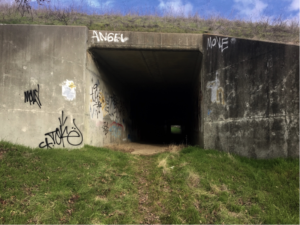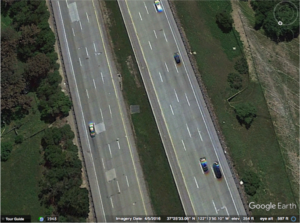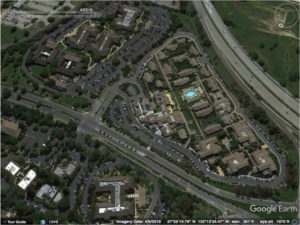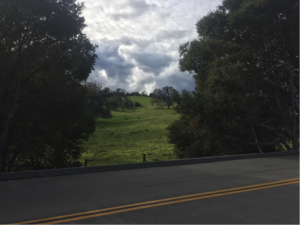I was always one of those kids who could take a road trip and just stare out the window and never be bored. I remember we took a road trip to Texas when I was about six, and as we drove through Pacheco Pass, where the wind farms covered the golden hills, I would imagine what it would be like to ride on one of the huge arms, and when we passed through Arizona, I would imagine living in the plateau-filled desert and making pots out of the clay I could find, and when we passed through half-abandoned, dust-blown towns in Texas, with their fading signs and rusted cars, I would imagine what it must have been like when the people were still there, when the stores had just opened.
As long as I can remember, I have been drawn to forgotten places–those odd concrete structures you see by freeways or in the middle of a roadside farm, those abandoned warehouses and stores, those old foundations of cabins still sitting in the woods. I feel a painful ache for places like that. With pretty much anything that’s been forgotten or abandoned, my mind immediately thinks back to its origin, when it was first built, who might have used it and appreciated the space, or called it home. I feel a need to honor and understand these abandoned places, to go into them and remember their origins. I guess I want, in some way, to warm the lonely spirit of a place through comprehension.
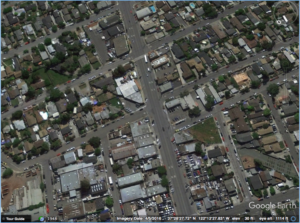
The strip of land where the Hetch Hetchy pipeline passes through is visible running from the top left to the lower right hand side.
At home, on the peninsula south of San Francisco, I devoted a lot of my free time to finding all of the oddities, secret places and forgotten parts of the land and cities. I remember once walking down Marsh Road after high school, and stopping by an old railroad track and seeing an odd scar through the land. The railroad cut through the suburban area like a knife, but there was also an oddly straight line of open plots and parking lots aimed at a totally different angle through the houses. I stood on the corner and looked back and forth at this, wondering why on earth this narrow strip of land was empty. I went home and spent hours studying satellite images of the area. This odd strip of undeveloped land cut straight through the entire eastern side of the peninsula, continued on for hundreds of miles across the bay, through the central valley, and then disappeared into the Sierra Nevada Mountains. I began to get a clue as to what it was when I saw what it became as it passed over the bay: two thick black lines. I figured it must have been an underground pipeline, one that couldn’t be built upon because of its importance or age. I thought back to driving down a steep, winding hill right next to Crystal Springs, the reservoir that served nearly the entire peninsula. There had been a blue painted pipeline that dove in and out of the hillside right next to the road; I remembered my mom telling me that that was Hetch Hetchy, California’s most important and longest water pipeline.
Several years before, my dad had taken me to ride my bike at the Pulgas Water Temple, a large, concrete circular structure held up by ornate pillars with water rushing beneath it.  That, it turned out, was where the water in the Hetch Hetchy pipeline finished its journey from the snow melt in the High Sierras, down the golden foothills, across the endless central valley, through the East Bay hills, over the bay and right though my neighborhood. Above those aging pipes, pumping water for miles and miles, is only this odd scar through the land that no one ever questioned and no sign explained. I had never expected to connect the water flowing through our kitchen sink and out of the showerhead to this scar in the land.
That, it turned out, was where the water in the Hetch Hetchy pipeline finished its journey from the snow melt in the High Sierras, down the golden foothills, across the endless central valley, through the East Bay hills, over the bay and right though my neighborhood. Above those aging pipes, pumping water for miles and miles, is only this odd scar through the land that no one ever questioned and no sign explained. I had never expected to connect the water flowing through our kitchen sink and out of the showerhead to this scar in the land.
I loved discovering connections like this and learning the hidden past to be found through the cryptic clues that the land held.
I must have been age thirteen, sitting in the back seat of our black Volvo station wagon as we drove down the 280 Freeway near Portola Valley, California, when I first noticed the grate. We used to drive down that freeway nearly every day, but the metal gutter settled in the long snaking island in the middle of the eight-lane highway had never caught my eye before. I found myself filling with the excitement of a high schooler in need of some sort of release and adventure.
Later that day, I opened up satellite images and observed the area. On one side of the freeway, there was a county road that came to an abrupt end where I could see the blurry brown smudge of an old bridge over a small brook and, farther down a trail, what looked like a concrete mouth opening just below the asphalt freeway. On the other side of the freeway was a similar structure, surrounded by trees and a mess of wooden fences separating two properties. When I saw that hint of a tunnel under the 280, I couldn’t help but wonder what it had been used for.
I used to go on long bike rides almost every weekend, and I would stop at Roberts Market, a very old general store right at the base of Windy Hill, in the Santa Cruz mountains. Inside, among the crammed aisles of canned food and cold drinks, were old photos of the Portola Valley area. Dirt roads crossed each other next to little wooden houses and stores. Horses drew carriages down the dusty streets, and the beautiful hills rose behind, covered with grazing cattle. Now the roads were kept smoothly paved, and the land was dotted with high-end houses, little community centers and well-kept hiking areas. This was west of the 280. But east of the 280, where I lived, was a relentlessly built-up suburban sprawl that grew thicker and thicker with people and buildings as you got closer to the bay. Built in 1955, the 280 Freeway had created a boundary between the growing suburbs, industries and companies expanding on the east side and the Santa Cruz mountains, big, spread-out houses on expansive plots and the grazing cattle and horse ranches that still existed on the west side.
One overcast day, I decided I would walk over to the tunnel and investigate. It was late winter, the California kind of winter, with 60-degree weather, dead trees and lush green hills. I emerged from my neighborhood onto the main road, Sand Hill, wearing cheap flip-flops covered in teeth marks from my dog, running shorts, a baggy shirt and a sweatshirt. I had just finished track practice, and now had the rest of the day to put off my homework by walking. Sand Hill Road approached the 280 perpendicularly and went over it on a bridge. To my right and left, oleanders lit up the green and grey surroundings with bright pink, white and magenta. The wind was warm and inviting, and the familiar smell of the green hills mixed with the exhaust from the freeway. The eucalyptus trees bent and swayed in the wind and the sky spat down occasional drops of rain. The sidewalk beneath me began as a well-kept footpath dotted with a line down the middle, separating runners and walkers passing on each side, before thinning to a narrow concrete path. Here, the curb was much higher than normal, as though the sidewalk had been thrown on at the last moment beside the busy road.
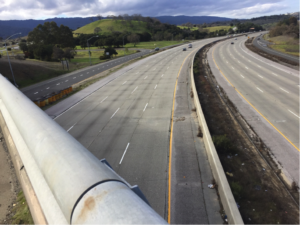 When I got to the on-ramp of the freeway and had to cross, the sidewalk turned into a mess of concrete chunks with dry weeds poking out from between the cracks, and shards of glass pressed into the fine sand that had built up as water carried it onto the street. The bridge over the freeway was unprotected; the cracked sidewalk lifted twenty feet above the rushing cars, with a railing only about as high as the middle of my thigh. The sky was growing heavier and heavier with moisture, although I felt pretty sure the imminent downpour would never come.
When I got to the on-ramp of the freeway and had to cross, the sidewalk turned into a mess of concrete chunks with dry weeds poking out from between the cracks, and shards of glass pressed into the fine sand that had built up as water carried it onto the street. The bridge over the freeway was unprotected; the cracked sidewalk lifted twenty feet above the rushing cars, with a railing only about as high as the middle of my thigh. The sky was growing heavier and heavier with moisture, although I felt pretty sure the imminent downpour would never come.
This was the height of the rainy season amid a drought that had been going on for years; it always seemed like the sky was holding itself back, growing darker and darker without any release. What little water dusted the ground would instantly dry up, as the deprived soil sucked the water into the cracks. I used to wonder how every year the grass still managed to turn green, even if for only a few months.
I crossed the freeway, and the sidewalk came to an abrupt end at the place where Sand Hill sloped upwards and a tiny county road turned off back towards the freeway. Sand Hill was smooth, dark and well-paved, as the high-end cars of those who lived in Portola Valley shot by, but the county road that branched off was practically dirt, the asphalt so weathered it resembled rough, cracked skin. This odd little road ran between the freeway and some open grassy hills partially covered with oaks. The road looked abandoned, but I could see the mark of people—beer bottles thrown on the side of the road, and a hardhat left next to the PG&E antenna halfway down the road’s length. Across from the antenna was a large wooden cross that looked dark against the grey sky. A white tank top with the Corona beer brand on the front was hanging on one side, flapping feebly in the wind.
I walked down the hill the road followed and saw where the road came to an end at a bramble of bushes and wide oak trees. On the right side of the road, a sign that read “No dumping” was half-buried under piles of gravel, broken-up concrete, wood chips and rock. The sweep of tires over the freeway had filled my ears for a while and lulled me into a false state of calm, countering the adrenaline building up as I approached the end of the road. The sun was setting, casting a yellow haze through the cracks in the clouds. I stood still at the end of the road, watching the grass sway and the clouds churn, still withholding their rain, before following a thin trail that lead into the bushes and over the small wooden footbridge. I stopped for a moment, thinking of the brown smudge I had seen in the satellite image and the chipped, peeling wood under my thin flip-flops.
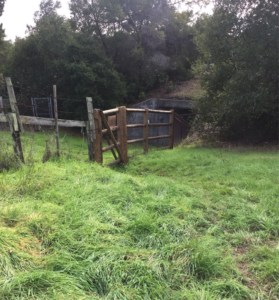 A concrete structure stood like open arms beneath the freeway, and I slowly turned toward them, following the trail. I stopped, this time unable to move as I saw the tunnel ahead of me. Its corners were pitch black, and a dim light shot at an angle through the metal gutter. I could see the other side, a small doorway into a lighter area, suggesting the outline of a fence covered in vines, and grass swaying in the wind. The floor of the tunnel was rock-hard dirt that had to have been mud at some point. Now frozen in time were the hoof marks of horses that had passed through however long ago. The walls held patches of graffiti that were chipping and wearing off. I could not see what could be leaning against the wall, or sleeping on the ground, or crawling about the darkest parts of the tunnel. I could hear the occasional drip of water, the sound so clear and sharp that it cut through the rush of the trucks and cars whizzing past right above me. I stared for a bit longer, feeling my eyes being drawn inwards towards the streaks of light coming through the gutter. I turned and walked away.
A concrete structure stood like open arms beneath the freeway, and I slowly turned toward them, following the trail. I stopped, this time unable to move as I saw the tunnel ahead of me. Its corners were pitch black, and a dim light shot at an angle through the metal gutter. I could see the other side, a small doorway into a lighter area, suggesting the outline of a fence covered in vines, and grass swaying in the wind. The floor of the tunnel was rock-hard dirt that had to have been mud at some point. Now frozen in time were the hoof marks of horses that had passed through however long ago. The walls held patches of graffiti that were chipping and wearing off. I could not see what could be leaning against the wall, or sleeping on the ground, or crawling about the darkest parts of the tunnel. I could hear the occasional drip of water, the sound so clear and sharp that it cut through the rush of the trucks and cars whizzing past right above me. I stared for a bit longer, feeling my eyes being drawn inwards towards the streaks of light coming through the gutter. I turned and walked away.
For the next few months I dreamt of that tunnel and watched with curiosity as it grew another meaning in my mind that stuck out like a tumor every time I saw it in my head. Between homework problems, I would go onto my computer and look at the satellite images, turning them back in time and seeing how the land had changed.

This 1948 image, taken before I-280 was built, shows Sand Hill Road running from the upper left to the lower right.
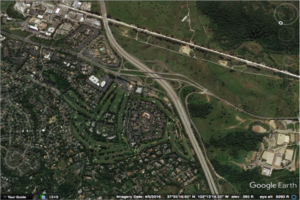
In this 2016 image, Sand Hill Road is dwarfed by the I-280 interchange.
One image, taken in 1948, was a black-and-white photo with the stunning clarity of film. In this image there was no freeway, and the golden hills extended far into where the budding suburbs were growing. In 1948, a square of land down the street from where I lived held two little homes surrounded by an orchard and a large, beautiful meadow. In 2016, the same square of land held 39 houses, packed together with their tiny backyards and short front lawns.
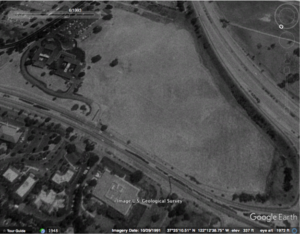
This 1991 image shows a field very close to where I lived. My mom used to walk on the trails that ran through the field with our Labrador, George. She would tell me about the burrowing owls that lived there.
Before the freeway was built, there were only grassy hills with cattle grazing and paths into the Santa Cruz Mountains. The tunnel, I guessed, must have been made so that cattle could pass through to graze on the other side. Now, of course, houses and yards, parted by big fences and paved roads, filled the area. There was no purpose for the tunnel now. I didn’t think anyone had entered it for years.
One evening, I was feeling gloomier than normal. I was inside our cramped apartment, the food my mom was cooking was hissing on the stove, my dad was fuming on the couch, the TV was blaring, and my brother was off hiding in the closet of our room, fingers on his video game. My phone was buzzing nonstop with texts from my friend who was panicking over something, and I was failing to calm her. I was lying on the dirty carpet, the stress of life pressing down on my lungs and filling my throat and eyes. My mom was silent, but I knew if she had been in a better mood, she would have told me to go take a walk. When I told her I was going out, she nodded without a second thought. I turned off my phone and left quietly so my dad would not hear.
Outside, it was beginning to get dark; the sun was already below the Santa Cruz Mountains and shadows were engulfing the neighborhood. I walked up Alameda de las Pulgas, through the little shops and thick neighborhoods, watching the orange gradient in the sky above the black silhouettes of trees and roofs slowly turn to the deep hues of twilight. Around me dogs were being walked, baby strollers pushed and windows in houses lit up. I looked in at families sitting down for dinner, children playing with their toys and lonely people watching their televisions.
I looked in at families sitting down for dinner, children playing with their toys and lonely people watching their televisions.
I had an idea of where I was going when I turned off the Alameda onto a dark, twisting road where there was only one street lamp every two blocks and the houses were large and spread out. The occasional black SUV or loud sports car shot through the darkness. It was pitch black now; the sky was clear and I knew the moon would rise any moment now.
I turned down a road with a sign that read “No Outlet.” It seemed here the city had given up on installing street lamps altogether and instead let the little lights above mail boxes lead the way. The moon rose above the East Bay hills and cast long organic shadows across the asphalt. I could hear the rush of the freeway, the thick tires on gravel, the roar of truck engines, the gurgle of motorcycles, and the sweep of air being displaced. I saw the open arms of concrete just beyond someone’s property, and I ducked under their old-fashioned wooden fence, the kind you see at the edge of ranches that is too high for horses to jump over, but is easy for smaller animals to scamper through. I rushed, crouched down, through the long grass surrounding their house and weaved through their small, overgrown orchard of olive trees, their waxy leaves white as if frosted in the cold moonlight. I heard the barking of dogs erupt from another person’s house, and I broke into a sprint over the uneven ground, thistles combing across my bare legs. I jumped into the air and grabbed the wooden rungs of a locked gate and threw myself over it.
I landed in a small pen, tall fences on three sides and the tunnel ahead of me. Plants had overtaken each of the fences, some dry and thistle-covered and others thorny a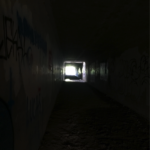 nd vine-like. The tunnel was thick and dark, parted in its center by streaks of pale moonlight, making a crumpled square of light on the uneven ground. On the other side of the tunnel, I could see the face of a hillside bathed in the moon’s light. I stared through for a while, letting the growl and howl of dogs behind me die down. I thought I could see something moving, not in the tunnel but on the other side, way up on the hillside. White like a sheet, the shape of a figure stood as tall as a human. It moved ever so slightly, wavering th
nd vine-like. The tunnel was thick and dark, parted in its center by streaks of pale moonlight, making a crumpled square of light on the uneven ground. On the other side of the tunnel, I could see the face of a hillside bathed in the moon’s light. I stared through for a while, letting the growl and howl of dogs behind me die down. I thought I could see something moving, not in the tunnel but on the other side, way up on the hillside. White like a sheet, the shape of a figure stood as tall as a human. It moved ever so slightly, wavering th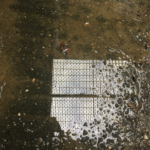 e way things do in the dark. My eyes were failing me; grey spots were engulfing parts of my vision the same way colors burst into your eyes when you rub them too hard. Now the dogs were silent, and I entered the tunnel quickly and quietly. The walls echoed and shook each time a car went over. When I stood in the light of the moon in the center, I looked down and could see my reflection against the metal grate looking back at me on the still water. I thought briefly back to the sunny day in the car when we had driven by and I had seen the grate from above.
e way things do in the dark. My eyes were failing me; grey spots were engulfing parts of my vision the same way colors burst into your eyes when you rub them too hard. Now the dogs were silent, and I entered the tunnel quickly and quietly. The walls echoed and shook each time a car went over. When I stood in the light of the moon in the center, I looked down and could see my reflection against the metal grate looking back at me on the still water. I thought briefly back to the sunny day in the car when we had driven by and I had seen the grate from above.
The walls groaned with echoing noise that seemed to express enigmatic longing.
That odd frame of the hillside that had been so small at the other end slowly grew larger as I got closer to the opening. The white figure seemed to grow smaller and smaller on the hillside as the landscape around it expanded. I couldn’t see where I was stepping, as if I were walking through a black fog that went up to my hips. I felt the tickle of moths grasping my ankles and then fluttering off. The walls groaned with echoing noise that seemed to express enigmatic longing. As I left the darkness of the tunnel and emerged onto the thin trail beside a single oak, before me lay the quiet open landscape of the hills and the oak forests with the black Santa Cruz Mountains looming above them. The grass was silvery and moved in shining waves as the wind passed over. Cars burst into and out of the quiet soundscape of crickets and wind through leaves and rustling in the bushes. The white figure was still standing on the hill, blurry in the low light. I didn’t feel threatened at all; I doubted they could see me, but there was something so calming and comfortable knowing I was not alone. I continued forward, straight off the trail, losing sight of the figure as I went down a steep grassy hill, the stalks brushing against my shins and the hard, dusty ground crumbling under my feet. I moved quickly into a little valley that curved away from the freeway. Soon all I could hear were the high-pitched ribbits of the thousands of tree frogs in a neighboring grove of trees and the crush of crisp, drought-laden ground under my feet.
I started up a steep hill again and came onto a ridge where everything was darker than before. The moon was behind a cloud and so every stump, every fallen branch, every jutting rock and thick shrub became a vague shadow in front of me. I thought of the coyotes and bobcats I had seen wandering the hills, and wondered if I would see the green reflection of their eyes in one of the shadows. To my left, the lights of the cities surrounding the bay flickered and blinked, reflecting off the black water. I heard a soft shuffle and sigh from down the ridge and saw, once again, the white figure, standing still with two faintly clear legs and a long silvery body, dimmer now that the moon was gone. I was transfixed, my muscles tight, my teeth clenched, my mind in awe. We looked at each other, the singing of the tree frogs and crickets fading into the back of my mind. I was terrified but warmed; I was not alone.
I was terrified but warmed; I was not alone.
I backed away and ran down the hillside, turning every other moment to see it standing still there on the ridge top, calm and serene, staring at me with knowing eyes. As I ran back towards the tunnel, the chorus of tree frogs returning to my ears, the figure resolved itself in my head into what it was—a white horse, ever focused and facing me, the rest of its four-legged body hidden by my perspective. I looked back once more and saw for the first time the vague outlines of darker colored horses standing half-asleep on the hillside. As I paused by the mouth of the tunnel, hands on my knees, breathing heavily, the lizards lying on the warm cracked ground crawled away from me. Maybe it didn’t matter what the tunnel’s purpose had been all those years ago. I entered it silently and then broke into a sprint. Maybe, for the forgotten tunnel, it was enough to be filled with life again for just this one night.

